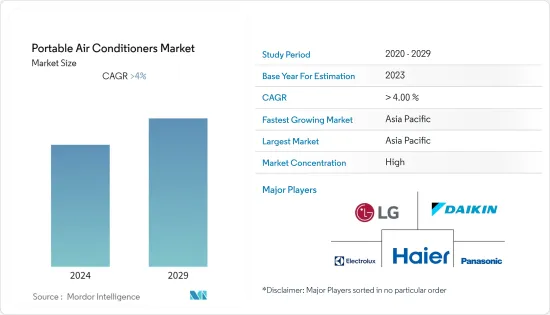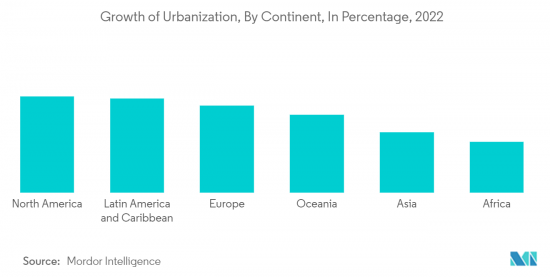 |
市場調查報告書
商品編碼
1408787
攜帶式空調:市場佔有率分析、行業趨勢/統計、成長預測,2024-2029Portable Air Conditioners - Market Share Analysis, Industry Trends & Statistics, Growth Forecasts 2024 - 2029 |
||||||
※ 本網頁內容可能與最新版本有所差異。詳細情況請與我們聯繫。
攜帶式空調市場今年的收益超過 11.2 億美元,預計在預測期內複合年成長率將超過 4%。

主要亮點
- 攜帶式空調市場的成長主要得益於快速都市化、家庭可自由支配支出的增加以及技術進步促使更智慧和節能產品的推出。推動攜帶式空調普及的其他因素包括移動性、安裝的簡易性/彈性以及與其他同類產品相比的經濟性。人們對環保、節能的攜帶式空調的需求不斷成長。攜帶式空調在亞太地區廣泛使用。
- 在COVID-19的早期階段,由於供應鏈中斷導致製造和分銷服務暫停,市場遭受損失。然後,鎖門和在家工作的文化增加了對冷卻系統的需求。自新冠疫情爆發以來,為因應季節性需求波動,市場成長緩慢。
- 過去兩年私人消費大幅增加。這為攜帶式空調商創造了一個機會,可以透過廣告和宣傳活動擴大市場佔有率,以適應不斷增加的消費者支出佔有率。
攜帶式空調市場趨勢
都市化帶動市場
- 世界各地的都市化進程正在迅速推進。由於資源的可用性和職業發展,人們從農村轉移到都市區。居住在都市區的人們經常因為工作承諾而改變他們的生活方式偏好。
- 隨著城市人口的增加,對冷卻系統的需求不斷增加。都市區的高溫也是需要攜帶式空調的原因之一。對於沒有建築物冷卻系統的公寓居住者來說,攜帶式空調是一個重要的解決方案。

商業領域主導市場
- 超級市場/大賣場、住宅大樓和商業綜合體使用攜帶式空調。由於都市化,商業建築領域正在快速成長,預計在預測期內對攜帶式空調的需求將會增加。
- 攜帶式空調主要用於閣樓、小型附屬建築和家庭辦公室。餐廳數量的增加是商業領域在攜帶式空調市場佔據主導地位的主要原因。
- 中小型公司、綜合大樓、公共場所是立式空調的主要使用者。亞太地區是商業場所使用可攜式空調的主導者。
行動空調產業概況
攜帶式空調市場分散,全球參與者眾多,因此規模較小的參與者很難從市場上的規模經濟中分得一杯羹。儘管如此,隨著技術創新產品和線上銷售的增加,攜帶式空調市場也為小型企業提供了空間。該報告涵蓋了攜帶式空調市場上的主要企業。
其他福利:
- Excel 格式的市場預測 (ME) 表
- 3 個月的分析師支持
目錄
第1章簡介
- 研究假設和市場定義
- 調查範圍
第2章調查方法
第3章執行摘要
第4章市場洞察與動態
- 市場概況
- 市場促進因素
- 氣溫變化帶動市場
- 市場抑制因素
- 有限的製冷能力限制了市場
- 市場機會
- 技術創新為新進者創造機會
- 產業價值鏈分析
- 洞察產業技術進步
- 產業吸引力波特五力分析
- 新進入者的威脅
- 買方議價能力
- 供應商的議價能力
- 替代品的威脅
- 競爭公司之間的敵對關係
- COVID-19 對市場的影響
第5章市場區隔
- 依產品類型
- 單管攜帶式空調
- 雙軟管式攜帶式空調
- 其他
- 依用途
- 住宅
- 商務用
- 依通路
- 直銷
- 多品牌
- 專賣店
- 線上的
- 依地區
- 北美洲
- 美國
- 加拿大
- 北美其他地區
- 亞太地區
- 印度
- 中國
- 澳洲
- 其他亞太地區
- 歐洲
- 德國
- 英國
- 其他歐洲國家
- 南美洲
- 巴西
- 阿根廷
- 南美洲其他地區
- 中東/非洲
- 阿拉伯聯合大公國
- 沙烏地阿拉伯
- 南非
- 其他中東/非洲
- 其他地區
- 北美洲
第6章 競爭形勢
- 市場集中度概況
- 公司簡介
- LG Electronics
- Haier
- Daikin
- Electrolux
- Panasonic
- Midea
- Whirlpool
- Robert Bosch
- Toshiba
- Carrier
- De'Longhi
- Honeywell
- Whynter
第7章 市場未來趨勢
第 8 章 免責聲明/關於出版商

The portable air conditioners market has generated a revenue of over USD 1.12 billion in the current year and is anticipated to register a CAGR of more than 4% for the forecast period.
Key Highlights
- The growth of the portable air conditioners market was primarily due to rapid urbanization, increased discretionary household expenditure, and technological advances leading to the introduction of more smart energy-efficient variants. Other factors driving the adoption of portable air conditioners include mobility, easy/flexible installation, and affordability as compared to other equivalents. There is growing demand for eco-friendly and energy-efficient portable air conditioners. The portable air conditioners are widely used in the regions of Asia-Pacific over others.
- During the initial stage of COVID-19, due to supply chain disruptions, the market has experienced losses due to stoppage in manufacturing and distribution services. Later, due to lockdowns and work-from-home culture, the demand for cooling systems has risen. Post-COVID, the market is experiencing gradual growth according to seasonal demand fluctuations.
- Consumer spending has observed a significant rise over the past two years. This creates an opportunity for portable Air Conditional players to expand their market share with advertisements and campaigns to occupy a share of increasing consumer spending.
Portable Air Conditioners Market Trends
Urbanization is Driving the Market
- Urbanization has been rapid over the years across the world. People shift from rural to urban areas due to the availability of resources and career growth. The people located in urban areas often shift their lifestyle preferences due to their work holic life.
- With the increase in urban populations, the demand for cooling systems is growing at a higher rate. High temperatures in urban areas are another demanding factor for portable air conditioners. Portable air conditioners are vital solutions for apartment dwellers who are not provided with building cooling systems.

Commercial Sector is Dominating the Market
- Supermarkets/hypermarkets, residential buildings, and commercial complexes are using portable air conditioners. Because of urbanization, the commercial building segment is growing rapidly, which is expected to increase demand for portable ACs during the forecast period.
- Portable air conditioners are mostly used for an attic, small disconnected rooms, and home offices. The growing number of restaurants is the main reason behind commercial segment dominance in the Portable Air Conditioners market.
- The mid to small-range companies, complexes, and public places are the main users of this standing type of air conditioner. Asia-Pacific is the dominant player in the usage of portable air conditioners in commercial places.
Portable Air Conditioners Industry Overview
The portable air conditioners market is fragmented, with many players with a large number of global players, which makes it quite difficult for small players to extract a share of economies of scale existing in the market. Despite this, with technologically innovative products and increasing online sales rising portable air conditioner market offers space to small players as well. The report covers major players operating in the Portable Air Conditioners market. Some of the major players in the Portable Air Conditioners market include LG Electronics, Haier, Daikin, Electrolux, and Panasonic, among others.
Additional Benefits:
- The market estimate (ME) sheet in Excel format
- 3 months of analyst support
TABLE OF CONTENTS
1 INTRODUCTION
- 1.1 Study Assumptions and Market Definition
- 1.2 Scope of the Study
2 RESEARCH METHODOLOGY
3 EXECUTIVE SUMMARY
4 MARKET INSIGHTS AND DYNAMICS
- 4.1 Market Overview
- 4.2 Market Drivers
- 4.2.1 Temperature Fluctuations are Driving the Market
- 4.3 Market Restraints
- 4.3.1 Limited Cooling Capacity is Restraining the Market
- 4.4 Market Opportunities
- 4.4.1 Innovations can Create Opportunities to New Entrants
- 4.5 Industry Value Chain Analysis
- 4.6 Insights into Technological Advancements in the Industry
- 4.7 Industry Attractiveness: Porter's Five Forces Analysis
- 4.7.1 Threat of New Entrants
- 4.7.2 Bargaining Power of Buyers
- 4.7.3 Bargaining Power of Suppliers
- 4.7.4 Threat of Substitutes
- 4.7.5 Intensity of Competitive Rivalry
- 4.8 Impact of COVID-19 on the Market
5 MARKET SEGMENTATION
- 5.1 By Product Type
- 5.1.1 Single-Hose Portable Air Conditioners
- 5.1.2 Double-Hose Portable Air Conditioners
- 5.1.3 Other Types
- 5.2 By Application
- 5.2.1 Residential
- 5.2.2 Commercial
- 5.3 By Distribution Channel
- 5.3.1 Direct Sales
- 5.3.2 Multi-brand
- 5.3.3 Specialty Stores
- 5.3.4 Online
- 5.4 By Geography
- 5.4.1 North America
- 5.4.1.1 United States
- 5.4.1.2 Canada
- 5.4.1.3 Rest of North America
- 5.4.2 Asia-Pacific
- 5.4.2.1 India
- 5.4.2.2 China
- 5.4.2.3 Australia
- 5.4.2.4 Rest of Asia Pacific
- 5.4.3 Europe
- 5.4.3.1 Germany
- 5.4.3.2 United Kingdom
- 5.4.3.3 Rest of Europe
- 5.4.4 South America
- 5.4.4.1 Brazil
- 5.4.4.2 Argentina
- 5.4.4.3 Rest of South America
- 5.4.5 Middle East and Africa
- 5.4.5.1 United Arab Emirates
- 5.4.5.2 Saudi Arabia
- 5.4.5.3 South Africa
- 5.4.5.4 Rest of Middle East and Africa
- 5.4.6 Rest of the World
- 5.4.1 North America
6 COMPETITIVE LANDSCAPE
- 6.1 Market Concentration Overview
- 6.2 Company Profiles
- 6.2.1 LG Electronics
- 6.2.2 Haier
- 6.2.3 Daikin
- 6.2.4 Electrolux
- 6.2.5 Panasonic
- 6.2.6 Midea
- 6.2.7 Whirlpool
- 6.2.8 Robert Bosch
- 6.2.9 Toshiba
- 6.2.10 Carrier
- 6.2.11 De'Longhi
- 6.2.12 Honeywell
- 6.2.13 Whynter*





